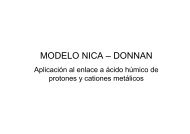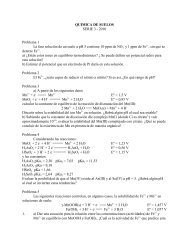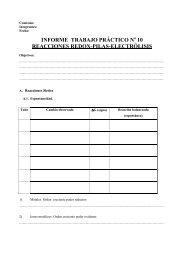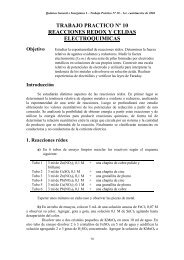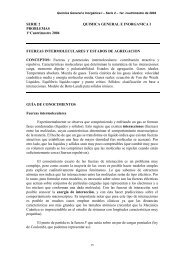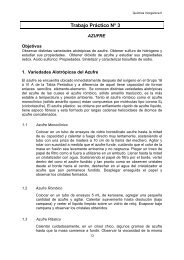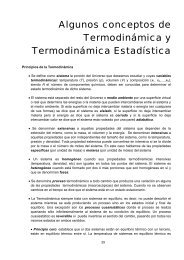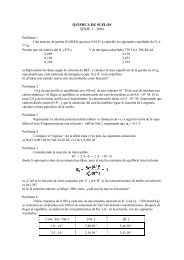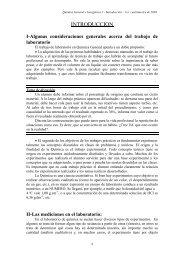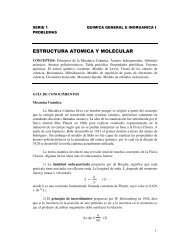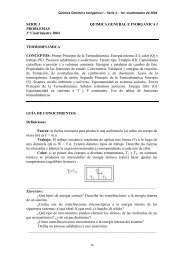Journal of Hazardous Materials Decontamination of hazardous ...
Journal of Hazardous Materials Decontamination of hazardous ...
Journal of Hazardous Materials Decontamination of hazardous ...
Create successful ePaper yourself
Turn your PDF publications into a flip-book with our unique Google optimized e-Paper software.
J. Sunarso, S. Ismadji / <strong>Journal</strong> <strong>of</strong> <strong>Hazardous</strong> <strong>Materials</strong> 161 (2009) 1–20 15Naphthalene was used as the model component to represent agroup <strong>of</strong> soil contaminants and 1-n-butyl-3-methylimidazoliumhexafluorophosphate [bmim][PF6] was utilized as the IL. The supercriticalextraction was carried out at 25, 35, 40 ◦ C and 80, 100, 120,140 bar conditions for 2, 4 and 6 h extraction times. They claimedthat the consolidation <strong>of</strong> these two “green” solvents is promising forrecovery <strong>of</strong> contaminated environment matrices in the near future.10. Modeling <strong>of</strong> equilibrium and dynamics in supercriticalextraction <strong>of</strong> <strong>hazardous</strong> substancesAdsorption and desorption processes under supercritical conditionhave been studied over a period <strong>of</strong> almost three decades.However, both equilibrium data and dynamic parameters, whichare required for the design <strong>of</strong> supercritical adsorption or desorptionprocesses are still necessary. One way to study the SFE processin detail includes the development <strong>of</strong> mathematical models andtheir application to experimental data. In this section, the staticand dynamic supercritical adsorption/desorption models that havebeen developed so far will be discussed.10.1. Adsorption/desorption equilibriumSupercritical extraction <strong>of</strong> organic contaminants from dry solidssuch as soil, adsorbents, etc., involves two different phenomenaoccurring simultaneously. The organic contaminant on the solidsurface can exist in two states, the adsorbed state and the depositedstate. The portion <strong>of</strong> the organic that is deposited as a separatephase on the solid surface is extracted by simple dissolution in thesupercritical phase. On the other hand, the extraction <strong>of</strong> the portion<strong>of</strong> the organic that is adsorbed on the solid phase is likely to becontrolled by adsorption/desorption equilibrium [204].At the equilibrium condition, the distribution <strong>of</strong> solutebetween the supercritical phase and solid phase can be determinedby the adsorption isotherm. There are a number <strong>of</strong>adsorption isotherm equations that can be used to correlate supercriticaladsorption/desorption equilibrium data, and the mostwidely used are Langmuir [98,164–166,169,175,205] and Freundlich[21,85,96,110,164–166,206] isotherm equations. Langmuirisotherm equation has the form <strong>of</strong>q ∗ =q∗ 0 K ′ Ce∗1 + K ′ Ce∗ (13)while Freundlich has the form <strong>of</strong>q ∗ = q ∗ 0 (C∗ e )1/n (14)Other available alternative isotherms are the linear adsorptionisotherm [162,163], BET model [21], Toth equation [160,207], andDubinin–Astakhov [208] equation.Adsorption and desorption processes <strong>of</strong> naphthalene, phenanthrene,hexachlorobenzene and pentachlorophenol from activatedcarbon in the presence <strong>of</strong> supercritical carbon dioxide were studiedby Madras et al. [167,110]. In their reports, adsorption/desorptionisotherms <strong>of</strong> these compounds were successfully modeled usingFreundlich isotherm. Fig. 6 shows the adsorption isotherm <strong>of</strong> hexachlorobenzeneon activated carbon at 308 K and 113 atm.Macnaughton and Foster [166] have obtained the adsorptionand desorption isotherm <strong>of</strong> the priority pollutant DDT on activatedcarbon at 313.1 and 318.1 K with a fixed carbon dioxide density <strong>of</strong>0.658 g/cm 3 . The equilibrium data can be described well by Freundlichmodel. Freundlich equation was also used to describe thesupercritical phenanthrene desorption isotherms from five dry soilmaterials [206]. Operating conditions <strong>of</strong> the measurements were at40–60 ◦ C and 120–310 atm. They found that the Freundlich equationis capable to adequately describe all <strong>of</strong> 40 isotherms obtained.Fig. 6. Adsorption isotherm <strong>of</strong> hexachlorobenzene on carbon at 308 K and 113 atmwith various values <strong>of</strong> K and n. Adapted from ref. [167].Supercritical extraction <strong>of</strong> phenol and 4-nitrophenol fromorganically modified smectite was performed by Park and Yeo[175]. They investigated the desorption characteristic <strong>of</strong> phenolsat three different temperatures and pressures up to 420 bar. Theadsorption/desorption isotherms <strong>of</strong> these compounds were wellpresentedby the Langmuir model.Dubinin–Asthakov equation, which is widely used to describegas and liquid phase adsorption isotherm, has also been usedto describe the adsorption equilibrium in supercritical condition.Dubinin–Astakhov (DA) equation has the following form( ) n ]RT ln(Pq ∗ = q ∗ 0[−′ exp /P s )E ′ (15)Shojibara et al. [208] used the Dubinin–Astakhov equation tocorrelate their adsorption equilibrium <strong>of</strong> benzene on activated carbonin the presence <strong>of</strong> supercritical carbon dioxide. The saturationcapacity, q ∗ , was found to decrease with the increasing pressure.0At constant temperature, as the pressure increases, the density <strong>of</strong>the carbon dioxide will escalate leading to the intensified solubility<strong>of</strong> the solute in the supercritical fluid. Thus, the amount <strong>of</strong> soluteadsorbed in activated carbon will also be reduced. On the otherhand, with the density increase, the amount <strong>of</strong> CO 2 adsorbed willalso be increased. Adsorption isotherms <strong>of</strong> benzene on BPL activatedcarbon under supercritical condition are shown in Fig. 7.Fromthis figure, it can be seen that at the supercritical condition (7.94 and11.87 MPa), the amount <strong>of</strong> benzene adsorbed in activated carbonincreases with temperature rise. At the pressure below crossoverregion, the density <strong>of</strong> supercritical CO 2 decreases with the increas-Fig. 7. Adsorption isotherms <strong>of</strong> benzene on BPL carbon. Adapted from ref. [208].



